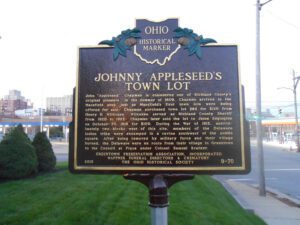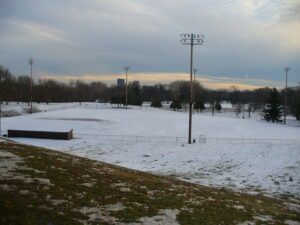, OH
On this site in 1848, the Presbyterians and Methodists entered into a situation unique to Gilean, as Grand Rapids was then known, by jointly constructing a frame church for worship. James Purdy, grantor, sold the lot for five dollars for religious purposes thereby authorizing either denomination to sell to the other. Proceeds were to be used to build another church. This ecumenical arrangement continued until 1880 when the Methodists sold their interest in the building to the Presbyterians in order to build a new church. The Presbyterians, whose charter included eleven members when they first organized at Guyer’s schoolhouse on September 18, 1848, built a new church here in 1928. One addition to the current building was made in 1961.
, OH
General John Hunt Morgan led a force of 2,000 Confederate cavalrymen into Meigs County during a raid north of the Ohio River. More than 50,000 Union troops and mlitia had been in pursuit of Morgan across Ohio. Near this site on July 18, 1863, Holliday Hysell and Dr. William N. Hudson were shot and killed by Confederate soldiers. These were the only civilians killed in Meigs County during Morgan’s Raid. After suffering losses at Buffington Island, Morgan surrendered eight days later near West Point in Columbiana County. The surrender field was the northernmost point reached by Confederate forces during the Civil War.
, OH
Macedonia Cemetery (circa 1840) belongs to Macedonia Church, Ohio’s first Black Church. Those buried include settlers of the Macedonia Free Black Settlement, built by free people who assisted freedom seekers along the Underground Railroad. Also interred are soldiers of the Civil War’s United States Colored Troops (USCT), most of whom served in the 5th Regiment, Ohio’s first Black Regiment (1863). The Polley family also rest here. Emancipated slaves, the family continued their freedom struggle when their children were kidnapped from Ohio and unlawfully sold into slavery. Macedonia’s extant burial grounds include this sacred site and another 1/2 mile north.
, OH
Findlay College was a joint venture of the Churches of God, General Conference, and the Village of Findlay. It was chartered on January 28, 1882, to provide a liberal arts education within a Christian context for all–regardless of race or sex. Old Main was constructed between 1883 and 1886 at a cost of $51,662.95. It was 171 by 107 feet, one of the largest college buildings in the state, and the only one heated by natural gas. The cornerstone was laid on May 25, 1884.
, OH
John “Appleseed” Chapman is considered one of Richland County’s original pioneers. In the summer of 1809, Chapman arrived in the Mansfield area just as Mansfield’s first town lots were being offered for sale. Chapman purchased town lot 265 for $120 from Henry H. Wilcoxen. Wilcoxen served as Richland County Sheriff from 1820 to 1825. Chapman later sold the lot to Jesse Edgington on October 30, 1818 for $100. During the War of 1812, approximately two blocks west of this site, members of the Delaware Indian tribe were encamped in a ravine southwest of the public square. After being removed by military force and their village burned, the Delaware were en route from their village in Greentown to the Council at Piqua under Colonel Samuel Kratzer.
, OH
On October 3, 1920 the first game matching two professional teams of the American Professional Football Association, a league that would become the National Football League (NFL), was held on this field within Triangle Park. In that game, the Dayton Triangles defeated the Columbus Panhandles 14-0. The Triangle’s Lou Partlow scored the first touchdown and George “Hobby” Kinderdine kicked the first extra point. Three factories founded by Dayton businessmen Edward Deeds and Charles Kettering sponsored the Dayton Triangles team. The factories were the Dayton Engineering Laboratories Company (DELCO), Dayton Metal Products Company (D.M.P.Co.), and Domestic Engineering Company (DECO), later call Delco-Light. They formed an industrial triangle of plants in downtown Dayton.
, OH
The 53rd Ohio Volunteer Regiment was mustered into service at Camp Diamond, north of Jackson, during the first year of the Civil War. Men recruited from the counties of Athens, Gallia, Jackson, Lawrence, Meigs, Pike, Ross, Scioto, Washington, and Hamilton, and Preble began arriving in camp for training in September 1861. On February 16, 1862, the army ordered the regiment to Paducah, Kentucky and there assigned it to General William Tecumseh Sherman’s command. From April 1862 to February 1865, the 53rd fought in 69 engagements, including the Battle of Shiloh (the unit’s first) and the Atlanta Campaign. After hostilities ended, the 53rd marched in the Grand Review in Washington D.C. on May 24, 1865 and was mustered out of service in Little Rock, Arkansas on August 11. The unit suffered 80 battlefield casualties; 196 men died of disease or accidents.
, OH
In 1796, surveyors for the Connecticut Land Company designated an area five miles square surrounding this place as Range 7, Township 7 of the Connecticut Western Reserve. A landowner’s expedition on June 15, 1798, arrived at the northwest corner of the township. One of its members, Thomas Umberfield (Umberville) brought his family to the center of the township (now Burton Village) on June 21, 1798. Here they built the first home, a simple log cabin located southwest of the spring at the end of Spring Street. The owner of the largest parcel of land in the township, Titus Street, was given the honor of naming the township. He named it after his son, Burton.









